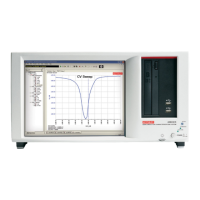4200-900-01 Rev. K / February 2017 Return to Section Topics 2-13
Model 4200-SCS User’s Manual Section 2: Model 4200-SCS Software Environment
How to create your own ITMs
Understanding the ITM definition tab
To define an ITM, use the ITM definition tab. Display it by double-clicking the ITM name in the
project navigator. Figure 2-4 shows and describes the ITM definition tab, in this case for the vds-
id ITM, which is part of the example project (shown in Figure 2-2 and Figure 2-3).
An ITM definition tab defines the ITM as follows:
• Schematically displays the type of device to be tested by the ITM (FET, BJT, capacitor, and
so on).
• Next to each terminal of the device, displays an “instrument object,” which acts as follows:
– Identifies the terminal (for example, gate, drain, source, collector, anode, and so on).
– Identifies and allows assignment / reassignment of the terminal to match the SMU,
GNDU, or open circuit that is physically connected to the terminal during the test.
– Displays the present forcing-function and measurement options for the terminal.
– Identifies and allows assignment and configuration / reconfiguration of SMU forcing
function and measuring options. A single-click of the force measure button displays the
Forcing Functions / Measure Options window for the terminal.
• Provides access to the Formulator, which allows in-test and post-test data computations.
• Allows setting of preconfigured speed or custom timing parameters for the ITM.
• Allows exit conditions to be set if the source goes into compliance.
• Allows you to select the measured readings (output values) that you want exported to the
Subsite Data sheet.
• Displays the present test mode:
– Sweeping
– Sampling
Understanding the ITM forcing functions
Table 2-2 summarizes the available ITM “forcing functions,” which tells the 4200-SCS how to apply
static or dynamic voltage or current conditions to device terminals.
Table 2-2
SMU Forcing function summary
General
type Name Description and graphical illustrations
Static Open Maintains a zero-current state at the terminal, subject to the maximum voltage compliance of the
connected SMU.
Common Maintains a zero-voltage state at the terminal, subject to the maximum current compliance of the
connected SMU.
Current
bias
Maintains a selected constant-current state at the terminal, subject to the user-specified voltage
compliance for the connected SMU.
Voltage
bias
Maintains a selected constant-voltage state at the terminal, subject to a user-specified current
compliance of the connected SMU.

